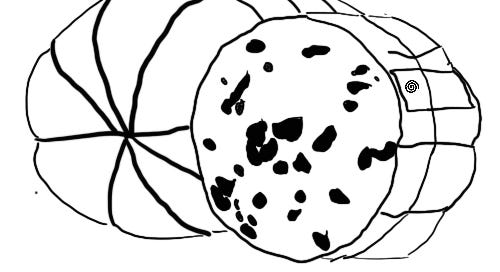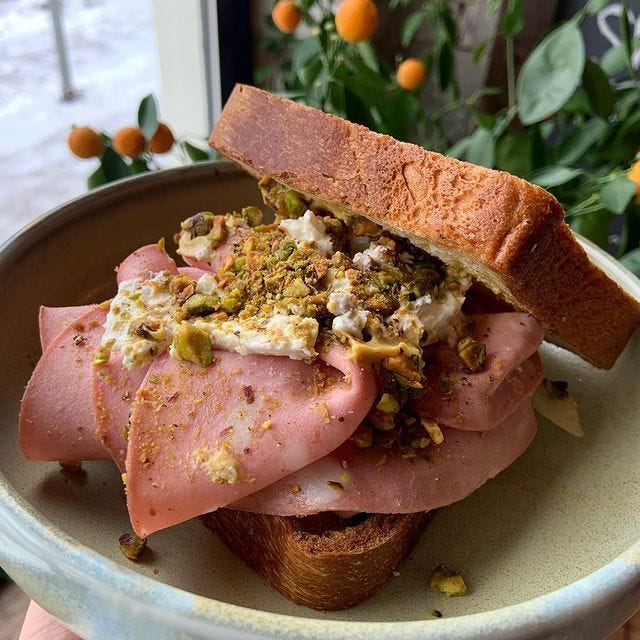Hi everyone! It’s been a while since we checked in. How is everyone doing? I want to thank everyone that takes the time to share their personal stories about the items we cover. Reminder, we are always open to suggestions (i.e.: asparagus!). Kevin and I are so grateful for this lovely community of curious folks.
It is rare for a cold cut to have a moment; it seems the last “hot meat” was prosciutto in the early 2000s. But these days mortadella seems to be everywhere and I’m here for it. It featured prominently in the Bon Appétit (RIP) classic video series “Making Perfect: Pizza.” NY Mayoral Candidate “Lil Mo Mozzarella” frequently orders it on his tours of Brooklyn sandwich shops. Influencers everywhere are posting pictures of their Mortadella Moments. Unlike most other cured meats, you really need a meat slicer to get the most out of a mortadella, making it perfect for restaurants or sandwich shops. Encased in a hoagie or forming little crisp mountains on a wood fired pizza, mortadella is the meat of the moment.
Choosing mortadella as our subject this week also provides a great opportunity to plug Stanley Tucci’s Italy. His new show on CNN is a region by region exploration of what a hunk Tucci is (and of course his love of Italian food). The show has become my favourite escape, to enjoy his sinewy, muscled-build barely contained by incredibly tailored outfits, hoovering carbs to his pie-hole and saying things with a straight face like “this rabbit is so tender” or “this pheasant is not too gamey” or the slogan of every talented chef, “looks like we will need more butter.”
There are many interesting themes tied up in the genesis and popularity of mortadella: craftsmanship, artisanal production, mass adoption, a sandwich counter called Wilensky’s and the nostalgia/rediscovery cycle. Let’s dive in.
Design
So what is mortadella? Traditionally, it is a fully cooked pork sausage containing at least 15% fat by volume. The meat is ground using a mortar and pestle or an industrial grinder to give it the uniform texture that it is known for. If you want to learn more, you can check out this page from the Italian Salami Institute (who, unfortunately, are not a degree-granting institution, but under their “health and wellness” tab they include a note that cured meats are “a pleasure for everybody”). Originating in the Emilia Romagna region of Italy, mortadella has been around for over 2,000 years, with the first written recipe dating back to 1644.
Emilia Romagna is known as the food valley of Italy because the climate and arid soil allow for wheat production and cultivation of cattle and pigs (and the associated products, cheese and sausages). Production of mortadella took off in Bologna, the capital of Emilia Romagna, and (allegedly) a quarter of Bologna’s 40,000 residents were responsible for mortadella production at 240 salumeries (cured meat factories) in the 17th century.
A couple years back, I took out ads on Craigslist offering to bring pork shoulders, legs, whatever if a family would let me participate in their annual salami making. To no one's surprise but my own, I got zero responses. Guess I should have tried Bologna in the 1600s. The closest I came to getting authentic salami was purchasing illegal salami from “the back” at a local Italian grocery store. If any of your friends are in the business, please forward them this newsletter. Will trade ad space for meat.
The popularity of mortadella led to things getting weird (counterfeit mortadella such as donkey mortadella and others), as well as the first product classified in what would eventually (400 years later) become DOP recognitions. DOP stands for Denominazione di Origine Protetta, a guarantee of the local production of an artisanal product. In Bologna, the Salaroli was created to enforce quality (and likely artificially inflate prices by constricting supply). If you were making morty without their permission, it was three turns on the rack and 200 gold coins. Actually. It got so wild that In 1661, Cardinal Farnese, representative for the Pope in Bologna, passed a law against the counterfeiting of mortadella. So if the Vatican is the instrument of God’s will on earth, is mortadella the holiest of meats?
DOP has continued to be key to the marketing of local products like Parmigiano-Reggiano, Balsamic, etc. Countries with food heritages have their own iterations and many food products are now protected by EU designations. The more recent iteration of mortadella with pistachios is not protected by DOP, sadly. The nuts make it feel healthy. Sorry, they “balance the natural richness.”
Innovation
Back then, it seems everyone was packing a salami in their suitcase when hitting the road, as mortadella made its way around the world through European migration. In Brazil, it is the star of a super popular sandwich at the Mercado Municipal that contains 1/2 pound of mortadella, provolone cheese, mayonnaise, dijon on a sourdough bun and then gets grilled… I have to try that.
As “uncle morty” immigrated from Italy to Germany and then to America, something got lost along the way turning mortadella, the pride of Bologna, into… Bologna, the pride of the Midwest. Now most often associated with prison lunches, Bologna actually has a long history of ushering industrialized food into North American homes.
Bologna production (and its co-innovation, the meat slicer - I was unable to verify this to Considered standards, but allegedly a mortadella producer, Alessandro Forni, also invented the meat slicer to increase mortadella consumption) received two huge bumps. The first was the public perception of industrial food as cleaner and healthier than traditional production (oh, how times have changed). The second was that mortadella imports were banned in the US from 1967 to 2000 because of a Swine Fever outbreak. There was even a Sofia Loren movie where she tries to smuggle in “La Mortadella.” Make a movie about Genoa Salami and another about Prosciutto Cotto and we can have The Muffaletta Cinematic Universe (the only MCU I recognize).
Oscar Meyer anthropomorphized bologna with its famous ad campaign. Shortly thereafter it became an affordable staple from Newfoundland to New Mexico.
Another byproduct of this broken sausage telephone is Montreal’s own Wilensky’s. Opened in 1932, and allegedly using the same grills since then, they specialize in a pressed beef salami and beef bologna sandwich called The Wilensky Special. The beef is a nod to the restaurant's Jewish heritage and the traditional avoidance of pork products. A favourite of Anthony Bourdain, David Cho and my father-in-law, it is available with or without cheese (Kraft or Swiss are the only options). There are two rules: they will not omit the mustard and they will not cut the sandwich for you. For less than $5, it is hard to beat.
Sustainability
Mortadella manufacturing is a business that reflects a whole animal thesis that is key to sustainable animal agriculture. While it does not make use of offal or other “off” cuts, it does reduce waste from trim that cannot be used in more classic cuts like chops or loin.
As well, the use of spices and salt preserves the meat well beyond its traditional harvest times. In the early 1900s it was packed in cans for preservation and shipping.
Industrial Bologna is a WHOLE other story. While its industrial production led to innovations like vacuum sealing (to prevent the product from drying out, a common complaint about turkey deli meats at the time… and forever since). It has often been used to feed people with little choice, like migrant farm workers, prisoners and children. High in sodium, nitrates and preservatives, it is not a healthy contribution to any diet.
Cost
Mortadella was known as the food of kings well into the 1800s. It was reportedly often given as a wedding gift (all I got was cash 😞). Currently, you are looking in the range of $2.50 to $9 per 100 grams. It is a steal compared to other Italian deli meats, largely because of its current lack of mainstream popularity. I was disappointed in humanity when I noticed how many SEO bait articles were titled “What is Mortadella?”
Because of the use of offcuts in Bologna production, consumption goes up during recessions and periods of economic struggle. Throughout the Great Depression it was one of the cheapest meats available and was a common source of protein on people’s tables.
If you live in a big city, the urban monoculture means that you can likely find a morty sando at your local hipster cafe. If not a morty sandusky, you can for sure find it in 2019’s favourite sandwich: the Muffaletta.
My local spot, Milou, does a weekly version. Doesn’t this look good? It comes in around $15.
Personally, I think mortadella makes a great addition to a made-at-home pizza. You can buy it in smaller quantities than pepperoni and it crisps up really well at residential oven temps (500 vs 900+ degrees for a pizza oven)! The internet, the terrible place it is, is filled with recipes where you line muffin tins with mortadella and bake it into cups you can then fill with whatever you want.
PS: I went to a summer camp with lots of grandchildren of Eastern European Jews who survived the Holocaust. On visitors day, the sheer volume of cold cuts and rye bread that was consumed must have cleared out every deli in Southern Ontario. The best part was a fellow camper whose grandfather brought him a 5 foot long cured beef salami that he tied to the rafter of the cabin. We would take slices from it whenever we wanted a snack. Did the cabin smell great? No. Did it smell great before the salami? Also no, but in a less definable way.










Mortadella was my go-to lunch in elementary school. Back then, and even now, I hated the peppercorns in the meat. My mom would pick up out the pepper in each slice...and I do the same to this day. A great sandwich meat with fresh bread!